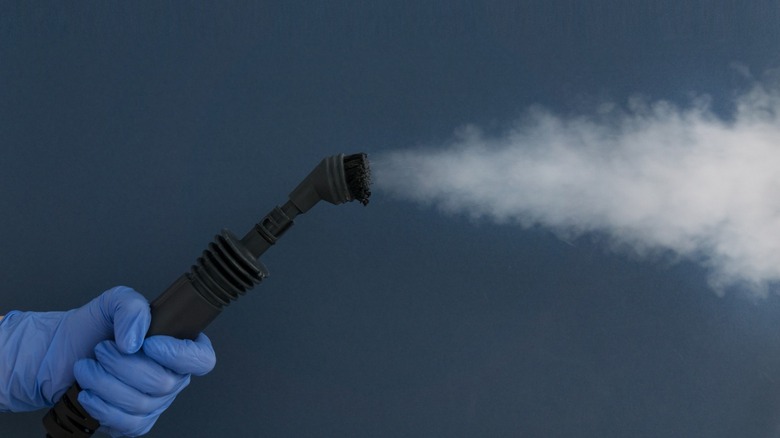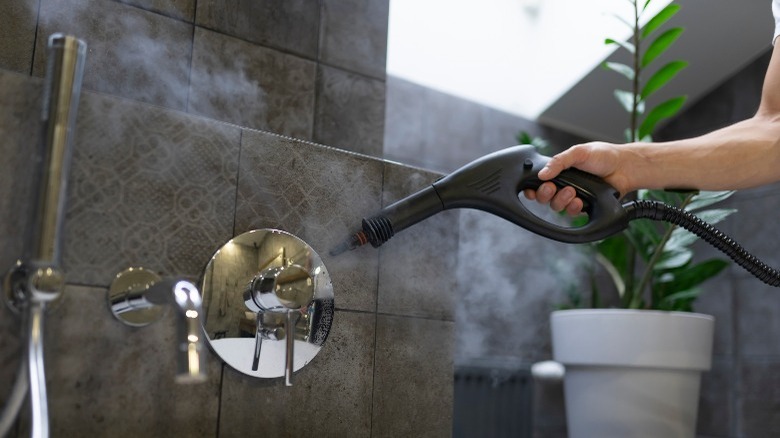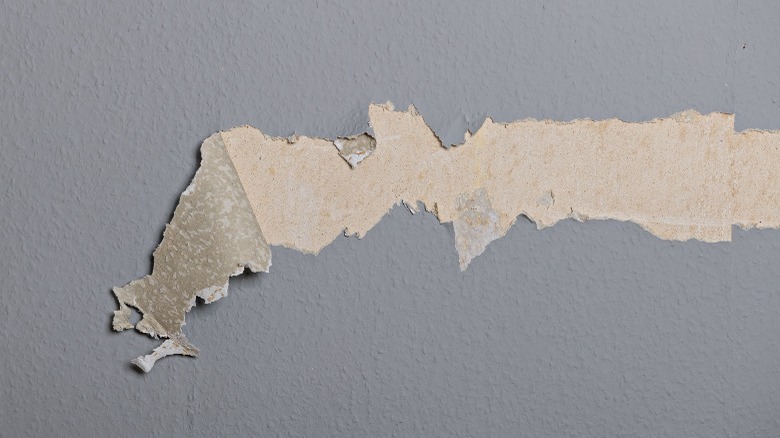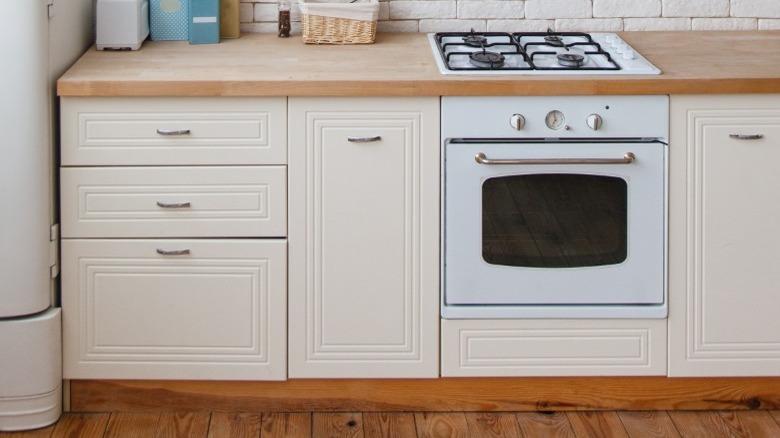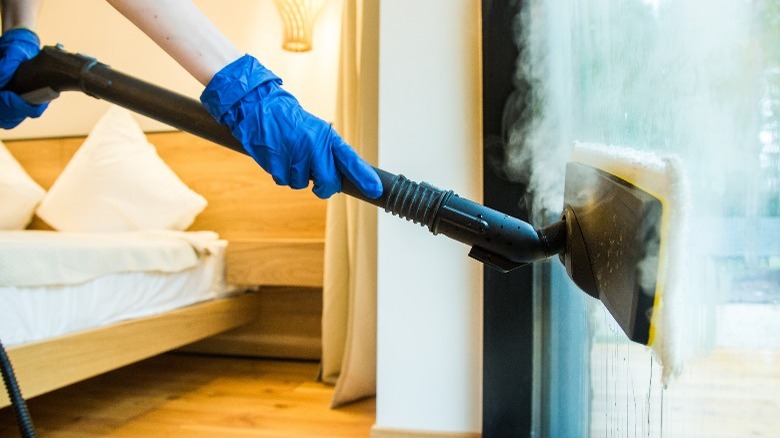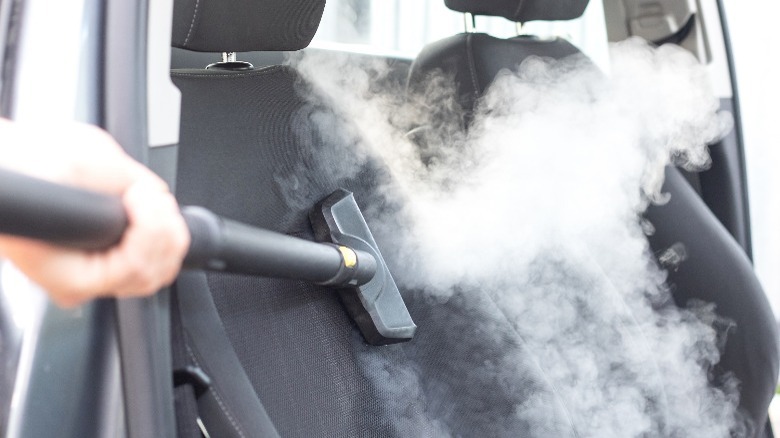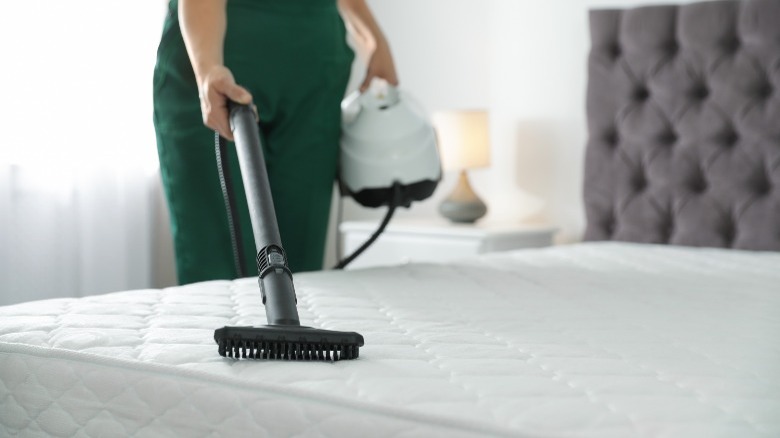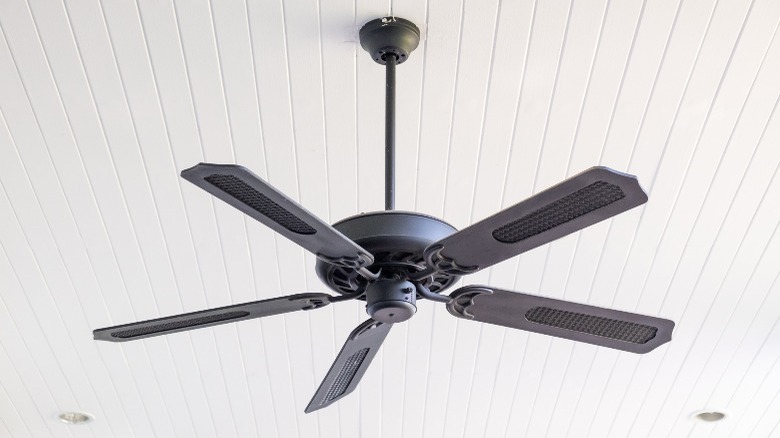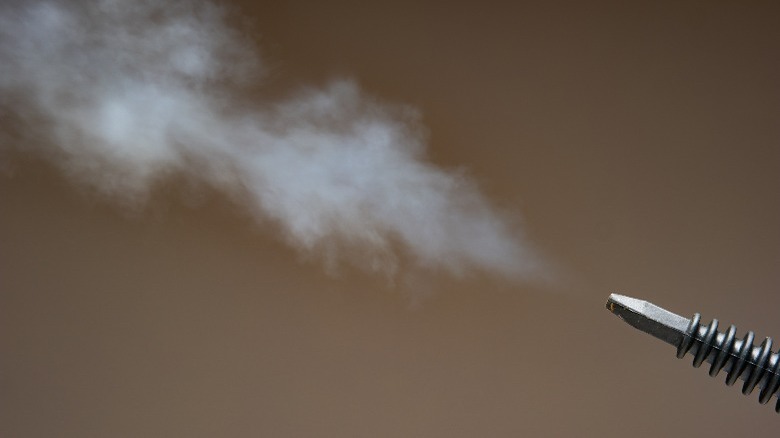Things You Never Knew You Could Clean With A Steamer
For many people, the COVID-19 pandemic has given them welcomed opportunities to spend more time at home. Unfortunately, that also means plenty of time to notice every little thing that's less than spotless. Thankfully, a steam cleaner is an excellent cleaning tool, and is even more versatile than you're aware. From car interiors to ceiling fans, a steam cleaner can handle it all! It works by heating water past the boiling point to create a high-temperature vapor that loosens dirt and debris before quickly evaporating. It also sanitizes surfaces, killing 99% of household germs including bacteria, mold, and dust mites, states Family Handyman.
Before you take off to steam clean to every inch of your home, here are some helpful hints to get the best results. Be sure to use the correct attachments appropriate for each surface or material you are cleaning. If your tap water is hard, use distilled water instead. And lastly, remember that the steamer is a hot tool, and remains hot for some time after use.
1. Clean tile and grout
Depending on the type of tile you have in your home, the effort it takes to clean it can vary. If your routine involves getting down to scrub on your knees, or straining to reach every corner of the shower, tile cleaning can take a physical toll. A steam cleaner can address these challenges and more. Lightweight and equipped with a far-reaching hose or spout, steam cleaners are designed for mobility and extending your usual range of motion. According to The Spruce, the steam can loosen dirt, soap scum, and even eliminate mildew forming in the grout joints — a notoriously difficult area to get truly clean.
When you're done, your grout will look brighter and your tile will be sparkling! A steamer can be used to clean other areas of your kitchen or bathroom as well, such as faucets, sinks, countertops, toilets, and mirrors. Most surfaces in these particular rooms should be fine, but never use steam to clean unsealed tile or stone that could suffer damage from high heat and moisture.
2. Remove wallpaper
Okay, so you can't use a steamer to clean your wallpaper per-se, but it would definitely come in handy if you need to remove it. Manual wallpaper removal can be an incredibly tedious and frustrating process, requiring many hours of peeling and scraping. Older wallpaper can be especially difficult, as the fragile material is likely to flake off in small sections. If you use a steamer, however, you can loosen the glue adhering the wallpaper and remove it more easily in larger strips, according to Lowe's. You may have to use a scoring tool to ensure the steam can reach the adhesive, but otherwise there is little prep needed before using the steam pad and scraping the wallpaper away as it loosens.
In addition to removing wallpaper, a steamer can be used to remove residue left behind by adhesives. If you have a steam pad, apply directly on the surface you need to clean. If you do not have a steam pad, you can hold the steamer a few inches above the affected area until the residue can be wiped away.
3. Clean your oven
Even for those who enjoy cleaning, addressing the oven can be a daunting task. Commercial products can contain toxic chemicals, and while there are non-toxic options available, they tend to require quite a bit of elbow grease. The good news is that you can use a steamer to clean your oven quickly, safely, and with minimal labor. As Bob Vila explains, the high-temperature steam will first loosen grease, grime, and food crumbs. You can then use a brush attachment and further dislodge any especially stubborn debris. When you've finished scrubbing, use a wet cloth to wipe up the remaining mess.
Cleaning the oven can be physically challenging, but the design of the steamer is ideal for getting to hard-to-reach corners. Similarly, this method can also be used to clean other appliances, such as microwaves, stovetops, and even refrigerators. The only downside is that you no longer have an excuse keeping you from tackling all of your appliances!
4. Make door and window glass shine
You can also use a steamer to clean glass windows and doors without the use of any cleaners or chemicals. With just water, you can clean thoroughly and leave nothing behind but a steak-free finish. Some steamers come equipped with a squeegee attachment specifically for cleaning glass, making the task even easier. Just make sure any attachments are clean from the prior use. For the most efficient cleaning, work from top to bottom of the area to grab any dirt or water that may drip down the vertical surface.
Though glass won't suffer water damage from the steam, you still need to take caution. As Home Steady warns, temperature variation between the boiling hot steam and cold glass to which it's applied can cause the material to crack or even shatter. They go on to advise homeowners to avoid steam cleaning windows on cold days, and opt instead for milder weather.
5. Detail your car
According to AAA, the average American spends just under an hour driving a car each day. That may not sound like a lot, but it can quickly add up to a significant portion of our lives spent in our cars. Like any other space, car interiors and their inhabitants can benefit from regular cleaning. But where to begin? Fortunately, a steamer is the ultimate tool for cleaning the interior your car, versatile enough to handle everything from upholstery to cup holders.
As a matter of fact, there are a variety of steamers produced and marketed solely for the purpose of cleaning your car. Designed to be lightweight and flexible, they are able to reach into all sorts of crevices to clean stains from mud, food, or anything else. In addition to the satisfaction that comes from executing a deep clean, you can also enjoy the much lower price point compared to professional car detailing services.
6. Disinfect children's toys
If you have young children, you already know they're both vulnerable to germs and prone to putting everything within reach into their mouth without a second thought. How we have managed to survive as a species, we can only guess. Fortunately, you can use a steamer to clean and sanitize everything from toys to strollers for worry-free care and play — or at least, worry-reduced.
A steamer is an excellent method for cleaning around young children since it doesn't require any dangerous tools or residue from harsh chemicals that could pose a safety risk. You can also avoid keeping chemical cleaners in storage where curious kids could unwittingly expose themselves to harm. According to Oh So Spotless, you can use the various attachments to quickly and efficiently steam clean stuffed animals, plastic toys, high-chairs, car seats, playpens, or anything else that can't fit in the washing machine. And less time spent cleaning means enjoying more time with your little one.
7. Sanitize your mattress
Even more than the time we spend in our cars is the time we spend asleep in bed. And thus emerges another area that requires cleaning — your mattress. There's no need to get overwhelmed, however, as it's already evident that a steamer can make cleaning less of a chore. Plus, cleaning your mattress with a steamer is relatively simple.
As The Spruce explains, you should deep clean your mattress with a steamer on a seasonal basis, if not more frequently depending on your use and habits. After stripping the bedding, start by vacuuming the mattress with an upholstery brush attachment. If there are visible stains, try spot treating with your favorite laundry stain remover. To steam, move the device few inches above the surface in long, slow movements. The mattress should be damp, but not wet. When you're finished, you should allow the mattress to dry completely before resuming use. You can now sleep well knowing your mattress is cleaner than before.
8. Clean your ceiling fan
The mantra "out of sight, out of mind" works great for managing unnecessary stress, but it can backfire when it comes to cleaning. Ceiling fans are another often-forgotten area of your home that could benefit from steam cleaning, as Oh So Spotless points out. Dust tends to accumulate on the blades, especially in the winter months when ceiling fans are infrequently used, if at all.
If you plan to use it to clean your ceiling fan, select a steam cleaner with a hose attachment long enough to eliminate the need for a ladder. This can make cleaning much safer, especially if you are home by yourself. A steamer is also a great tool because the cloth attachment will trap loose dust instead of just pushing it into the air to fall onto the space below. Methods such as this can help you maintain better air quality in your home, which can be especially beneficial to anyone suffering from indoor allergies.
9. What not to clean with steam
As helpful as it is to learn about all the different things you can clean with your steamer, it's also important to know what you should never steam clean. Not every material is able to withstand the contact with water or high temperatures, so it's best to think carefully before proceeding. Otherwise, you run the risk of causing stains, warping, or other irreparable damage. A good rule of thumb, according to Bob Vila, is to avoid steam cleaning anything that shouldn't be exposed to excessive moisture or high heat.
For example, you should avoid using a steamer on items such as unfinished wood surfaces, hardwood floors, latex-based painted surfaces, musical instruments, electronics, leather, delicate fabrics such as silk or velvet, light fixtures, electronics, and unsealed tile or stone. This is by no means a complete list, so be sure to check labels and cleaning instructions before attempting to steam clean anything you haven't before. Now that you know the dos and don'ts, you can steam clean your home with confidence and ease!
